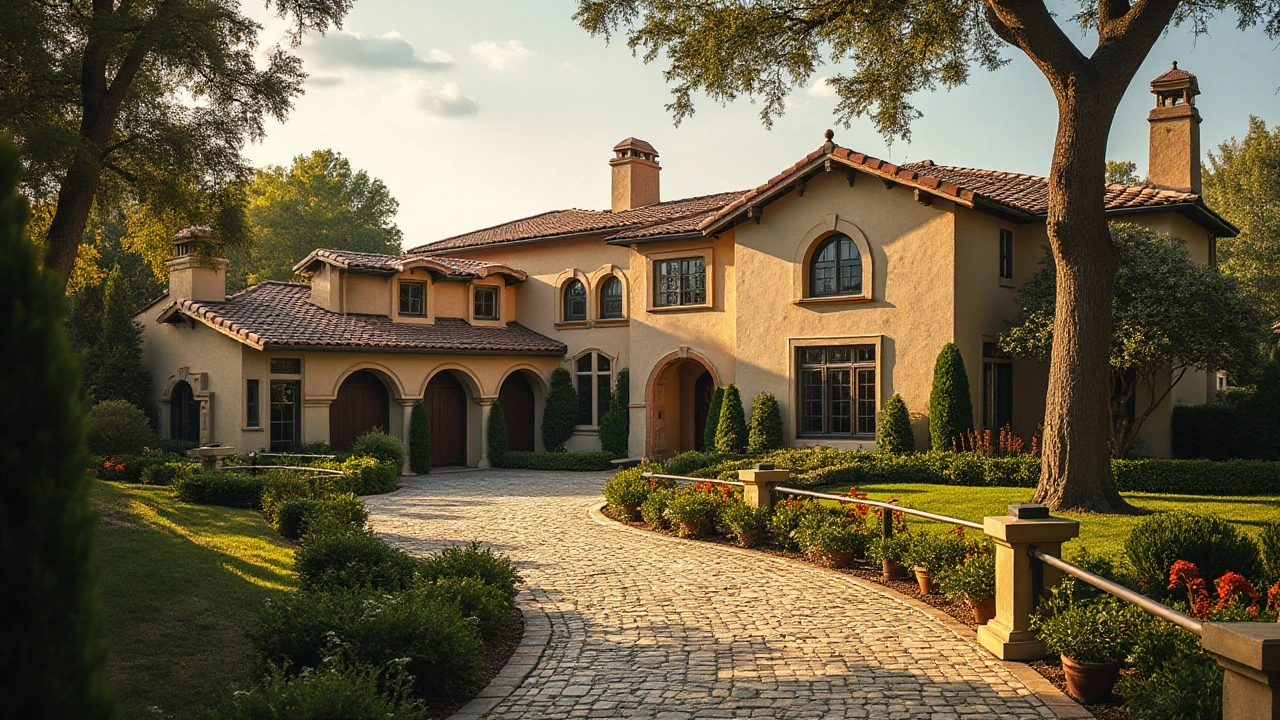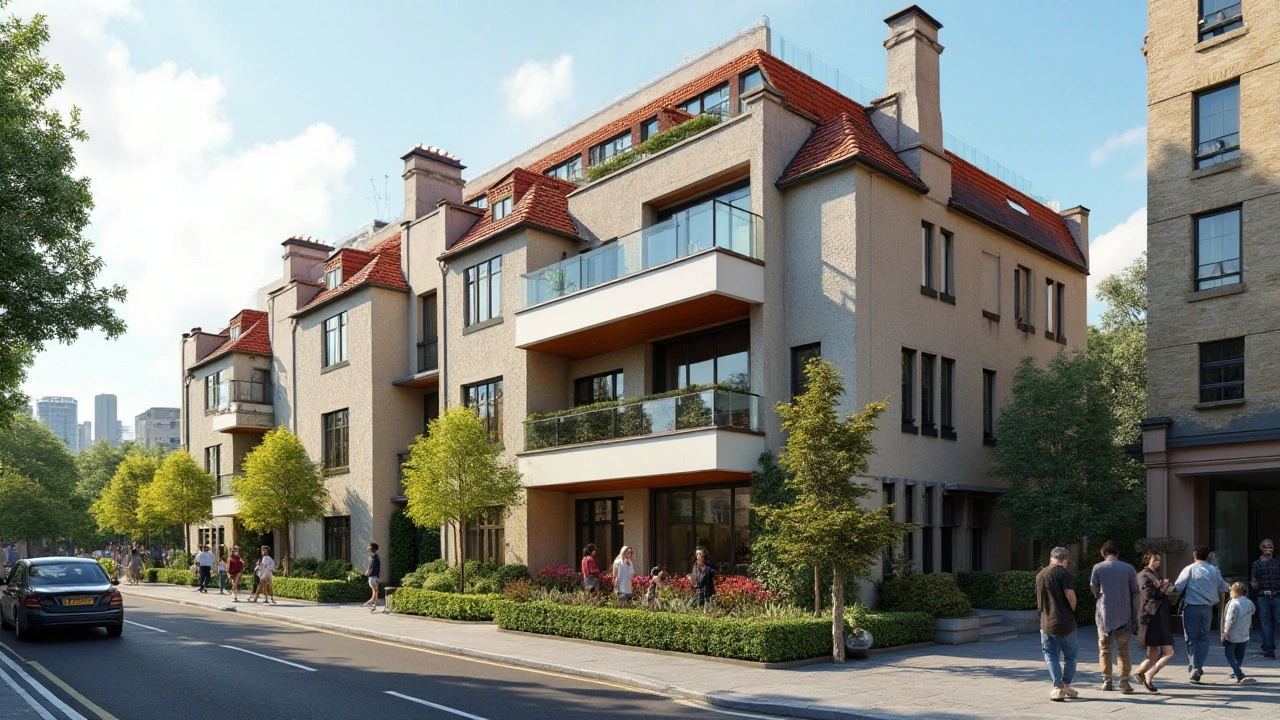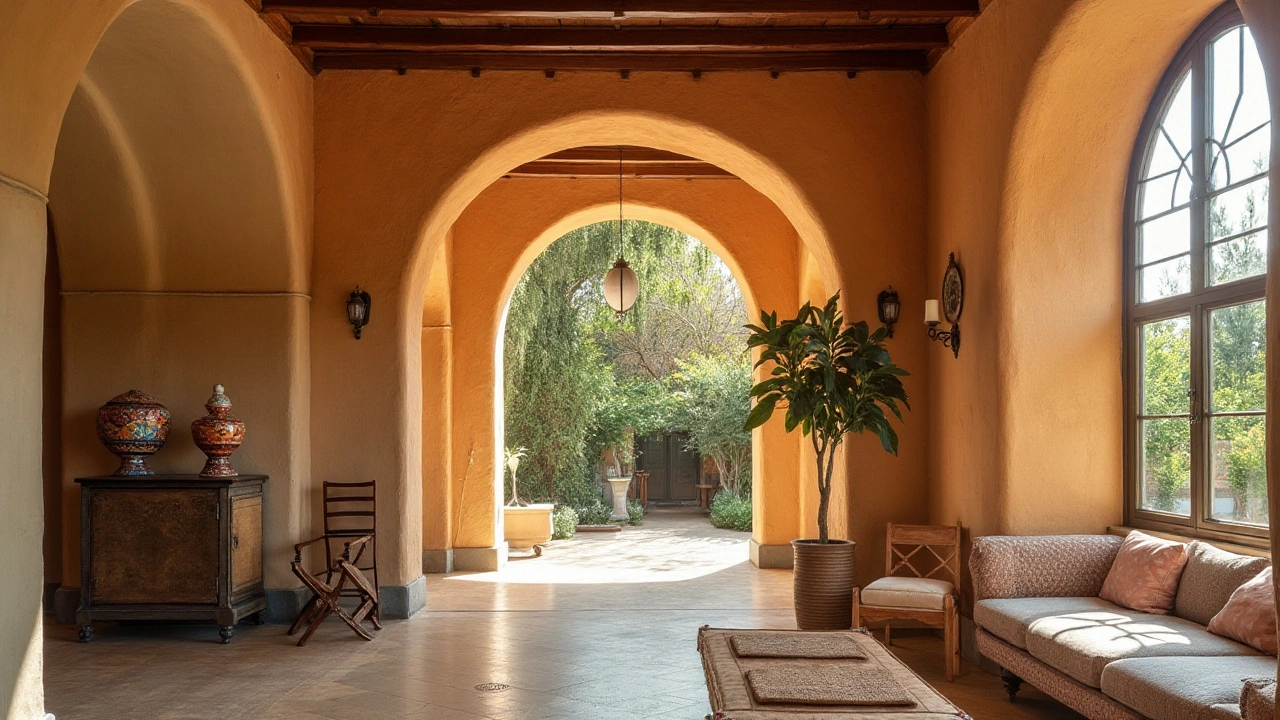Mediterranean Revival Architecture: Impact on Contemporary Design Trends
 Nov, 2 2024
Nov, 2 2024
Mediterranean Revival Architecture, with its roots tracing back to the early 20th century, is an enchanting style that harmonizes historical elements with modern comfort. Initially inspired by the coastal charm of the Mediterranean countries like Spain, Italy, and parts of France, this architectural style has traveled across oceans, finding a home in warm, sunny locales across the world.
Its enduring appeal lies in the signature use of terracotta roofs, stucco walls, and elaborate archways, design elements that evoke a sense of warmth and openness. Modern architects have embraced these features, preserving their aesthetic while adapting them to contemporary needs such as energy efficiency and sustainable materials.
This blend of old and new not only offers a timeless beauty but also fulfills the modern desire for spaces that are both functional and welcoming. By examining how Mediterranean Revival influences today's architecture, one can uncover valuable insights into crafting beautiful, sustainable homes and public spaces.
- The Origins of Mediterranean Revival Architecture
- Key Characteristics of Mediterranean Design
- Influence on Modern Residential Design
- Mediterranean Elements in Public Spaces
- Future Trends in Mediterranean Architecture
The Origins of Mediterranean Revival Architecture
The early 20th century was a time when cultural exploration and architectural innovation were thriving, leading to the birth of the Mediterranean Revival Architecture style. This architectural approach was a direct homage to the picturesque coastal homes lining the shores of the Mediterranean Sea, particularly in countries like Spain, Italy, and Greece. The fascination with Mediterranean aesthetics began to take hold in America, notably in Florida and California, where the sunny, warm climates resonated with the spirit of the design. This style became highly fashionable during the 1920s and 1930s, coinciding with the rise of Hollywood, where the romantic allure of the Mediterranean was often depicted on screen.
The guiding principle of Mediterranean Revival was to create layouts that embodied casual living, celebration of the outdoors, and a sense of luxury without the ostentation. Architects were intrigued by the idea of blending scents, sounds, and textures reminiscent of seaside getaways. These designs drew from a rich tapestry of influences, including Spanish Renaissance, Italian Renaissance, and Gothic styles. As noted by the celebrated architect Addison Mizner, “The quiet elegance of these old-world designs was unmatched.” Mizner played a pivotal role in popularizing this style in the U.S., particularly in Palm Beach, where he left a significant architectural legacy that still draws admiration today.
The influence of European tours for wealthy Americans cannot be overstated in this exchange. These tours exposed them to the sun-drenched elegance and intricate architectural details of Mediterranean resorts and villas, inspiring them to bring a slice of that beauty back home. It wasn't long before the style was adopted for both opulent estates and more modest dwellings. Key presidential and public buildings also incorporated Mediterranean design elements, which further embedded the style into the contemporary architectural lexicon. This was a time of rapid growth and change, and the Mediterranean Revival offered a fresh, compelling aesthetic that appealed to the desire for new beginnings and exoticism in the early 20th century.
During this period, architects began experimenting with specific design elements that have now become synonymous with Mediterranean architecture. The use of red-tiled roofs, whitewashed walls, and wrought-iron details created an enchanting architectural aesthetic that's both charming and functional. Arched windows and doors, along with courtyards and outdoor living spaces, made residences feel expansive and integrated with nature. These design choices didn't merely serve an aesthetic purpose but fostered a sense of serenity and contemplation. Mediterranean Revival buildings were more than just structures; they created an ambience that celebrated life's simple pleasures.
Key Characteristics of Mediterranean Design
The allure of Mediterranean architecture lies in its artful blend of elegance and rustic charm, a combination that resonates with both history and comfort. One of its defining features is the use of stucco exteriors that create soft, textured surfaces with earthy tones. These walls not only reflect the sunlight beautifully but also help in keeping homes cool in the hot climates where this style thrives. This architectural approach is practical and aesthetic, aligning perfectly with its origins by the sun-drenched Mediterranean coastlines.
Red clay roof tiles are perhaps the most recognizable feature of this style. Their curved, interlocking form adds visual interest and functionality, quickly channeling rainwater off the roofs to avoid water damage. These tiles are inspired by the ceramics of ancient Rome and have been adapted over centuries to enhance durability. Besides their functionality, they also provide a striking contrast to the serenity of whitewashed walls, creating a bold yet harmonious visual signature.
Another characteristic worth noting is the generous use of arches and asymmetrical facades, which lend a sense of movement and flow throughout the structure. Entrances, windows, and arcades often feature these arches, framing the view and inviting the outside in. This seamless integration of interior and exterior spaces is a hallmark of modern design influenced by Mediterranean Revival. Gardens, courtyards, and terraces play a pivotal role here, serving as extensions of the main living areas and offering spaces for relaxation and entertainment.
Inside, you can often find earthy textures and natural elements like wood and stone, which add warmth and authenticity to these spaces. High ceilings with exposed beams and wrought iron accents on rails and fixtures reflect the unique craftsmanship that is integral to this style. Walls may feature intricate tile work with colorful mosaics that capture the essence of the sea and sky. A respected architectural historian once said,
"Mediterranean homes have this beautiful ability to transport you to another place and time with their simplicity and understated elegance."
Emphasizing a well-lived aesthetic, the floor plans are typically open, facilitating airflow and allowing light to flood the interiors. This is complemented by large windows and French doors that invite nature inside. The color palette is warm and inviting, often featuring tones of terracotta, olive green, and oceanic blue, all working together to craft a serene, inviting atmosphere. The use of architectural influence from various Mediterranean cultures not only provides a rich visual tapestry but also inspires modern designers to adopt and innovate it further.
For anyone considering adopting this style in their home or building project, start by incorporating these visual and structural elements. The goal is to create a space that feels like a sanctuary, echoing the casual elegance and comfort that the Mediterranean design trends are known for. Adding personal touches like handcrafted details or vintage furnishings can further elevate the authenticity of the space. The combination of materials, light, and open space creates a timeless and magnetic appeal that continues to captivate architectural enthusiasts and homeowners alike.

Influence on Modern Residential Design
In recent years, the elegant charm of Mediterranean architecture has seamlessly blended into the tapestry of modern residential design. This revival style brings a distinctive flair, inspiring architects and homeowners to incorporate its classic elements into contemporary living spaces. The origins of this architecture, steeped in coastal life, prioritize a seamless interaction between indoor and outdoor environments. This has become a cherished aspect of modern design, where bringing nature closer enriches our homes.
One of the most identifiable elements of this style is its signature red-tiled roofs, which not only provide an aesthetic appeal but also offer durable protection against the elements. This characteristic roofing, traditionally made of terracotta, naturally regulates temperature—a concept highly valued in today’s eco-conscious world. Modern adaptations often include energy-efficient materials that maintain the traditional look while offering enhanced sustainability.
Stucco walls and intricate ironwork are other iconic features transferred to contemporary homes. These aspects not only elevate the visual interest of a structure but also offer practical benefits such as lasting durability and low maintenance. Many designers today emphasize open floor plans, which are in line with Mediterranean influences, aiming to create expansive, airy rooms that allow light to flow freely.
The architectural historian Margaret Gillespie once remarked, "The Mediterranean style invites warmth and life into a house. It celebrates not merely by its beauty but by the lifestyle it accommodates." Her words reflect the essence of why this style so effectively influences modern living—the pursuit of a joyous, inclusive lifestyle, harmonizing with nature.
Another popular facet borrowed from Mediterranean homes is the use of courtyards and expansive patios. These areas serve as perfect venues for social gatherings or solitary relaxation, offering a serene escape while maintaining a connection to the house's interior. This concept of outdoor living has gained immense popularity particularly in regions where mild climates permit year-round enjoyment of such spaces.
Beyond the physical attributes, the philosophy of this style deeply resonates with the modern sensibility of eluding complexity. It embraces minimalism without losing warmth, allowing designers to create spaces that are both luxurious and approachable. This balance is achieved by judiciously using natural textures, earthy tones, and rich embellishments that define the style's character.
Adding to the allure, modern residential design incorporating Mediterranean elements often features intricate mosaics and hand-painted tiles. These are used in flooring, backsplashes, and focal walls, offering a personalized artistic touch that feels both timeless and fresh. Some homeowners even go a step further, incorporating domed ceilings and wooden beam accents to complete the homage to traditional Mediterranean aesthetics.
Mediterranean Elements in Public Spaces
Incorporating Mediterranean architecture into public spaces brings about a unique blend of aesthetic pleasure, cultural appreciation, and functional design. This architectural style is not just limited to residential areas; it flourishes in plazas, parks, and even commercial settings where it can add a touch of elegance and warmth. Signature elements like arched colonnades, stucco walls, and terracotta detailing are prominently featured, creating spaces that are not just visually appealing but also deeply rooted in history. These spaces often become cultural hubs, reflecting the romanticism of the Mediterranean coastline and providing a nostalgic nod to the ancient designs of Greek and Roman times. Visitors and locals alike can bask in the charm of these spaces, finding them perfect for leisure and social interaction.
Modern design trends widely embrace these elements to infuse character and a sense of place into urban planning projects. These techniques create courtyards that echo the grand patios of Andalusian palaces, allowing natural light to fill the space and fostering community interaction. Water features, reminiscent of traditional Mediterranean fountains, lend a soothing auditory backdrop, enhancing the tranquillity of public areas in bustling city settings. Such features are not just aesthetic choices; they embody a valuable design strategy that harmonizes the urban environment with natural elements. Al fresco dining areas decked with wrought iron furniture and shaded by vine-covered pergolas add a rustic charm, making public spaces cozy and inviting. These designs often function as a testament to the versatility and timeless appeal of Mediterranean influences.
Many urban planners find that embracing these design trends can significantly boost tourism and local engagement. Town squares, designed with Mediterranean inspiration, often become iconic landmarks, drawing visitors who appreciate their beauty and historical resonance. A notable example is the refurbishment of Miami's Coral Gables, where Mediterranean Revival architecture set the stage for a vibrant community focal point. Here, the playful use of colors, textures, and historical references not only preserve the past but innovate the present, creating an engaging blend of new and old. Incorporating these features into key public sites can often breathe new life into community spaces, making them integral to social and cultural gatherings.
"The beauty of Mediterranean architecture is that it isn't just about visual appeal; it's about fostering community and creating spaces that people can connect with," states a well-known urban designer.
As cities grow and evolve, the challenge often becomes balancing functional requirements with the desire to maintain a unique cultural identity. Mediterranean elements help achieve this balance by offering a toolkit of vibrant, human-centric design choices. They offer an idyllic charm that appeals widely—a rare blend of relaxation and sophistication. Vibrant mosaics can adorn public benches, pathways can be designed to mimic the winding alleys of a Mediterranean village, and gardens planted with native species can create microclimates conducive to gatherings and outdoor events. Such spaces offer a retreat from the hustle and bustle, inviting visitors to pause, reflect, and enjoy their environment.
The allure of Mediterranean design in public spaces lies in its ability to tell stories—stories of cultural exchange and historical precedence while maintaining a modern functionality. Architects and planners continue to explore and expand these ideas, crafting public venues that resonate both with historical depth and contemporary needs. These spaces become not just places to visit but experiences to savor, offering a sensory journey through sight, sound, and texture that leaves a lasting impression on all who visit. As the world looks toward sustainable and resilient urban development, the influence of Mediterranean design principles in public spaces offers a blueprint for creating enduring, vibrant communities.

Future Trends in Mediterranean Architecture
As we move forward into an era increasingly dominated by technology and sustainability, the beloved Mediterranean architecture finds itself at an intriguing intersection of tradition and innovation. Today, architects are continuously reinterpreting this classical style, integrating its iconic elements with contemporary needs for eco-friendly and smart designs. The future of Mediterranean architecture promises to be about blending the old-world aesthetics with new-age efficiency and minimal environmental impact.
One of the key trends shaping the future of Mediterranean architecture involves utilizing sustainable materials and techniques which not only reduce the carbon footprint but also preserve the timeless beauty of the design. Architects are now incorporating reclaimed and local materials such as clay, stone, and wood to maintain authenticity while improving sustainability. This approach not only respects the traditional aesthetics but also aids in fostering a more sustainable, localized form of construction. As solar panels and energy-efficient designs become mainstream, there's a growing focus on integrating these technologies without compromising the classic Mediterranean essence of the architecture.
Moreover, these modern adaptations are seen in how architects use open floor plans and large glass windows to adapt the style to today's lifestyle preferences, which prioritize natural light and open, airy spaces. These design choices maintain the visual connection to the surrounding environment—a hallmark of Mediterranean structures—which enhances the sense of harmony between indoor and outdoor living spaces. The graceful arches and high ceilings continue to provide a sense of space, while the incorporation of green building technologies ensures these homes are energy-efficient and sustainable.
In urban settings, Mediterranean design is making strides beyond residential areas. Public spaces and commercial buildings are increasingly utilizing Mediterranean elements to create inviting, stylish environments. The use of courtyards, terraces, and lush gardens in urban architectural designs not only injects a dose of tranquility into bustling cityscapes but also contributes to urban biodiversity and microclimates. Many architects find inspiration in traditional Mediterranean designs to create comfortable, functional public spaces that cater to modern urban needs without losing touch with the elegance of its heritage.
Looking toward the horizon, digital advancements are weaving their way into the architecture industry, creating new paradigms for Mediterranean design. Virtual reality and 3D modeling allow architects to explore endless possibilities with Mediterranean-inspired designs, ensuring that they manage to preserve the style's traditional warmth and functionality while experimenting with new forms and techniques.
As renowned architect Rafael Moneo once articulated, "Architecture is not about fixing image for all eternity but how life is organized, how space is organized." This sentiment is guiding many in the field as architects who look to the past to inform an innovative future, making Mediterranean Revival an enduring choice as design trends evolve.